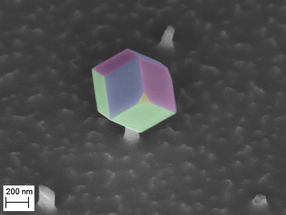Luminescent nano-architectures of gallium arsenide
A team at the HZB has succeeded in growing nanocrystals of gallium arsenide on tiny columns of silicon and germanium. This enables extremely efficient optoelectronic components for important frequency ranges to be realised on silicon chips.

The GaAs nanocrystal has been deposited on top of a silicon germanium needle, as shown by this SEM-image. The rhombic facets have been colored artificially.
S. Schmitt/HZB

Intensity distribution of the six optical modes in the rhombic-dodecahedron is shown along two rectangular cross sectional planes.
HZB


Gallium arsenide semiconductors have better optoelectronic properties compared to silicon. Those properties can be controlled and altered by specific nanostructures. Dr. Sebastian Schmitt, Prof. Silke Christiansen and their collaborators have succeeded to obtain such a nanostructure on a silicon wafer covered with a thin, surprisingly crystalline layer of germanium. Colleagues from Australia had produced the high-quality wafer and sent it to HZB. The thin film of germanium facilitates the growth of gallium arsenide crystals because the lattice constants of germanium and gallium arsenide are almost identical.
They etched deep trenches in these wafers at intervals of a few micrometers until only a series of fine silicon columns topped with germanium remained on the substrate. Gallium arsenide was then deposited using metal organic vapor phase epitaxy (MOVPE). In this way, both gallium and arsenic atoms were systematically deposited on each germanium-capped silicon tower, forming a tiny, almost-perfect crystal. “The germanium acts like a crystallisation nucleus”, explains Schmitt who is the author of the study published in Advanced Optical Materials.
The nano-architecture looks spectacular under the electron microscope. At first glance, it seems as if you can see a cube on the tip of each silicon needle. At second glance, it becomes apparent that it is actually a rhombic dodecahedron – with each of the twelve surfaces an identical rhombus.
This nano-structure exhibits unusually high optical emission after excitation with a laser, especially in the near-infrared region. “As the GaAs crystals grow, germanium atoms also become incorporated into the crystal lattice”, explains Schmitt. This incorporation of germanium leads to additional discrete energy levels for charge carriers that emit light when falling back to their original levels. The light is then amplified by means of optical resonances in the highly symmetrical nanocrystal, and the frequency of these resonances can be controlled by size and geometry of the crystals. A large number of these so-called photonic resonances could be detected in the experiment that also agree well with numerical calculations.
“Because the optical and electronic properties of semiconductors can be strongly modified by nanostructuring, such nano-architectures are well suited for developing novel sensors, light-emitting diodes, and solar cells”, says Schmitt.
Original publication
"Germanium template assisted integration of gallium arsenide nanocrystals on silicon: a versatile platform for modern optoelectronic materials"; S. W. Schmitt, G. Sarau, C. Speich,G. H. Döhler, Z. Liu, X. Hao, S. Rechberger, C. Dieker, E. Spiecker, W. Prost, F. J. Tegude, G. Conibeer, M. A. Green and S. H. Christiansen; Advanced Optical Materials; 2018.
Original publication
"Germanium template assisted integration of gallium arsenide nanocrystals on silicon: a versatile platform for modern optoelectronic materials"; S. W. Schmitt, G. Sarau, C. Speich,G. H. Döhler, Z. Liu, X. Hao, S. Rechberger, C. Dieker, E. Spiecker, W. Prost, F. J. Tegude, G. Conibeer, M. A. Green and S. H. Christiansen; Advanced Optical Materials; 2018.
Topics
Organizations
Other news from the department science

Get the chemical industry in your inbox
By submitting this form you agree that LUMITOS AG will send you the newsletter(s) selected above by email. Your data will not be passed on to third parties. Your data will be stored and processed in accordance with our data protection regulations. LUMITOS may contact you by email for the purpose of advertising or market and opinion surveys. You can revoke your consent at any time without giving reasons to LUMITOS AG, Ernst-Augustin-Str. 2, 12489 Berlin, Germany or by e-mail at revoke@lumitos.com with effect for the future. In addition, each email contains a link to unsubscribe from the corresponding newsletter.



























































